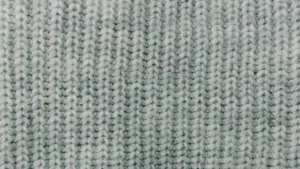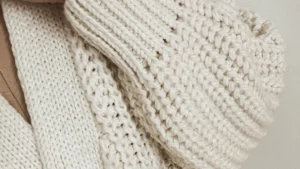
When choosing knitwear materials, focus on yarn quality and type. These things affect how long sweaters last and work well. Good yarn helps sweaters avoid fuzz, keep their shape, and stay nice after washing. Knowing the fiber type and rules also helps you pick wisely. By choosing good materials, you can make great sweaters that customers and businesses want.
Tip: Check yarn strength and washability to match your needs.
Key Takeaways
Pick good yarn to make sweaters last and look nice longer.
Select fibers based on use; wool and alpaca are warm, while synthetic fibers are strong.
Check for labels like OEKO-TEX to ensure yarn is safe and eco-friendly.
Use mixed yarns to get the best of natural and synthetic fibers.
Learn about eco-friendly methods and trends to please customers and improve your brand.
Yarn Quality: Key Characteristics and Standards
What Makes Yarn High-Quality
Good yarn is key for strong and nice-looking sweaters. You can spot it by its smooth feel and even thickness. It should have few flaws. The type of fiber matters a lot for quality. For example, wool is soft and stretchy, making it a top choice. Alpaca is another great option. It is warm and feels silky.
Check if the yarn resists pilling. Pilling creates tiny, messy balls on fabric. High-quality yarn avoids this, keeping sweaters neat after many uses. Washing is also important. Good yarn keeps its shape and color after being washed. This makes it perfect for long-lasting clothes.
Tip: Look at yarn details like fiber type and weight to match your needs.
What Affects Yarn Strength
Strong yarn is important for long-lasting knitwear. The fiber type decides how tough the fabric will be. For instance, wool is strong and handles wear well. Mixed yarns, like wool blended with synthetics, are softer and more durable.
How yarn is spun also matters. Tightly spun yarn is stronger and breaks less. Yarn weight is another factor. Heavy yarn makes thick, tough fabrics but may feel less soft. For sweaters, balance weight and comfort carefully.
Weather can also affect yarn. Sunlight and moisture may weaken it. Pick yarn that fits the sweater’s purpose. For cold weather, alpaca yarn is great because it keeps you warm and dry.
Yarn Quality Certifications and Standards
Certifications prove yarn meets safety and quality rules. As a buyer, look for labels like OEKO-TEX. This ensures the yarn is safe and free from harmful chemicals. It’s vital for brands that care about safety and the environment.
Other standards check yarn strength and color staying power. These help fabrics stay strong and look good over time. Following these rules helps protect your brand’s reputation.
Note: Working with an OEKO-TEX supplier makes sourcing easier and ensures steady quality.
Knowing these yarn facts helps you pick the best materials for sweaters. This improves your products’ quality and builds customer trust.
Material Composition in Knitwear Materials
Knowing what knitwear is made of is important. It helps you pick the right yarn for your products. The type of fiber in yarn changes how good, strong, and useful sweaters are. Let’s look at natural fibers, synthetic fibers, and mixed yarns.
Natural Fibers: What They Are and How They’re Used
Natural fibers come from plants or animals. They can break down naturally and are eco-friendly. These fibers are soft, comfy, and let air through, making them great for nice sweaters.
Wool: Wool is stretchy and warm, perfect for winter clothes. It doesn’t wrinkle and keeps its shape for a long time.
Cotton: Cotton is light and airy, great for summer sweaters. It soaks up water but might shrink if not treated.
Alpaca: Alpaca is super warm and feels silky. It’s also good for people with sensitive skin.
Silk: Silk makes clothes fancy. It’s smooth, shiny, and light but needs careful washing.
Each fiber works best for certain uses. Wool is great for cold weather, while cotton is better for light, casual sweaters.
Tip: Look for labels like OEKO-TEX when buying natural fibers. This shows they are safe and eco-friendly.
Synthetic Fibers: Pros and Cons
Synthetic fibers are made by people, often from oil-based materials. They have good points but also some downsides.
Good Things:
Stronger and last longer than most natural fibers.
Dry fast and don’t wrinkle, so they’re easy to care for.
Cost less, which helps lower production expenses.
Bad Things:
Made from non-renewable resources, which can harm the planet.
Don’t let air through well, which can feel hot in warm weather.
Fibers like polyester and nylon are tough and used in activewear. But they aren’t as soft or eco-friendly as natural fibers.
Note: Think about how the sweater will be used. Synthetic fibers are great for sports or outdoor wear because they’re strong and dry quickly.
Blended Yarns: Mixing the Best of Both
Blended yarns mix natural and synthetic fibers. This makes yarn that’s both strong and versatile. It’s great for making better sweaters.
Wool-Polyester Blend: Combines wool’s warmth with polyester’s strength. Good for everyday sweaters.
Cotton-Spandex Blend: Adds stretch to cotton, making it great for snug sweaters.
Alpaca-Nylon Blend: Mixes alpaca’s softness with nylon’s toughness for long-lasting clothes.
Blended yarns let you create materials that fit your needs. They’re also a cheaper way to make good-quality sweaters.
Tip: Check how much of each fiber is in the blend. More natural fibers make it softer, while synthetic ones make it stronger.
By learning about knitwear materials, you can choose yarns that match your brand’s quality and what customers want.
Sustainability in Material Choices
Sustainability is now very important for choosing knitwear materials. As a B2B buyer, you can pick materials that help your business and the planet. Knowing how materials affect the environment helps you meet customer needs and follow industry trends.
Why Sustainability Matters in Knitwear
Using sustainable materials cuts down on waste and pollution. It also supports fair and ethical production methods. Many customers like brands that care about the planet. Choosing sustainable yarns lets you meet this demand while keeping sweater quality high. Sustainable choices also improve your brand’s image, which helps your business succeed long-term.
Eco-Friendly Fiber Options
Natural fibers are often the best for sustainability. Fibers like wool, cotton, and alpaca break down naturally and can be reused. Organic cotton uses less water and avoids harmful chemicals. Recycled wool is another great choice. It reduces waste but still keeps sweaters warm and soft.
Some synthetic fibers can also be eco-friendly if recycled. Recycled polyester and nylon use fewer resources than new ones. These fibers are strong and work well for durable knitwear.
Tip: Find suppliers who offer recycled or organic fibers to boost sustainability.
Certifications to Look For
Certifications prove that materials meet environmental and ethical rules. OEKO-TEX ensures yarns are safe and chemical-free. The Global Organic Textile Standard (GOTS) checks organic fibers and eco-friendly production. These certifications help you confirm the quality and sustainability of your materials.
Certification | Focus Area | Benefits for Buyers |
|---|---|---|
OEKO-TEX | Chemical safety | Guarantees safe and eco-friendly yarns |
GOTS | Organic and sustainable production | Confirms organic fiber content |
Recycled Claim Std | Recycled materials | Verifies use of recycled fibers |
Balancing Sustainability and Quality
Sustainability doesn’t mean giving up on quality. Blended yarns, like wool-polyester mixes, combine eco-friendly fibers with strong synthetics. These blends make durable sweaters that last longer.
Think about how long your products will last. Good yarns resist fuzz and keep their shape after washing. This means fewer replacements, which helps the environment.
Note: Durable sweaters made with sustainable materials reduce waste and make customers happy.
Practical Steps for Sustainable Sourcing
Look for suppliers who focus on sustainability. Many offer eco-friendly options that still have high quality.
Ask for certifications to check the environmental impact of materials.
Pick fibers that match your product needs. For example, organic cotton is great for light sweaters, while recycled wool works for winter clothes.
Stay informed about new sustainable yarns. Technology is always improving eco-friendly options for knitwear.
By choosing sustainable materials, you can make top-quality knitwear that helps the planet and meets customer expectations. This approach benefits the environment and makes your brand stronger in the market.
Impact of Yarn Quality and Composition on Knitted Sweaters

Durability and Longevity in Knitwear
The yarn used greatly affects how long sweaters last. Good yarn stays strong and keeps sweaters looking nice for years. For example, cashmere is soft and strong, making it great for fancy sweaters. Wool is tough and warm, perfect for everyday or sporty sweaters.
Sweaters that resist fuzz are better. Tightly spun yarn or blends like wool-polyester help avoid fuzz balls. Yarn type also affects washing. Good yarn keeps its color and feel after many washes. This makes sweaters last longer and keeps customers happy.
Tip: Check yarn details to match your durability needs.
Comfort and Wearability for Luxury Knitted Sweaters
Luxury sweaters must feel soft and cozy. Yarn type is key for comfort. Cashmere is super soft and warm, great for fancy or casual sweaters. Alpaca feels silky and is gentle on sensitive skin.
Breathable yarns are important too. Wool and cotton let air through, keeping wearers comfy in any weather. Lightweight yarns like silk blends add style and comfort for formal sweaters. Sporty sweaters need synthetic blends that stretch and dry fast.
Note: Blend yarns to balance comfort and strength in your sweaters.
Industry-Specific Applications of Knitwear Materials
Different industries need different sweater materials. Fashion brands use cashmere or silk blends for fancy sweaters. These materials look classy and attract high-end buyers. Formal sweaters often use wool or wool-polyester blends for a neat and durable finish.
Sportswear uses nylon and polyester because they’re tough and dry quickly. Everyday sweaters work well with cotton or cotton-spandex blends for comfort and flexibility.
Knowing yarn features and matching them to industry needs helps you make better products. This builds trust with customers and improves your brand’s reputation.
Practical Tips for Sourcing High-Quality Knitwear Materials
Evaluating Yarn and Material Quality
Checking yarn quality is key for making strong, nice sweaters. Start by looking at the fiber type. Natural fibers like wool and alpaca are soft and warm. Synthetic fibers like polyester are tough and last longer. Mixed yarns combine these features for many uses. Pick yarns with even thickness and few flaws for smooth finishes.
Yarns that resist fuzzing keep sweaters looking neat longer. Washing well is also important. Good yarn keeps its shape, color, and feel after many washes. Certifications like OEKO-TEX show the yarn is safe and eco-friendly. This helps you trust your material choices.
Tip: Ask suppliers for samples to test yarn strength and washing results before buying a lot.
Choosing Reliable Suppliers
Good suppliers help you get top-quality knitwear materials. Research suppliers with strong reputations in the industry. Find ones who sell bulk yarn for sweaters and socks. Reliable sock makers often share yarn details to help you choose wisely.
Look for certifications like OEKO-TEX to ensure safety and sustainability. Clear communication is important too. A good supplier explains yarn types, fiber blends, and options clearly. Building strong supplier relationships can lead to better deals and access to new materials.
Note: Visit trade shows or events to meet trusted suppliers and see their products.
Staying Informed on Trends and Innovations
The knitwear world changes fast with new ideas and customer needs. Knowing trends helps you pick materials that match what people want. New tools include smart knitting machines, eco-friendly yarns, and AI design systems. Sustainability is a big focus, with brands choosing greener materials.
Stay updated by reading industry news and following top sock makers and yarn sellers. These sources share info on new tech and green practices. Using these ideas can improve your products and grow your business.
Tip: Try eco-friendly yarns like recycled polyester or organic cotton to meet the demand for sustainable sweaters.
Knowing about yarn quality and material makeup is very important. Good yarn makes sweaters strong, comfy, and work well. This helps your products do better. Look at fiber types, certifications, and eco-friendly options. These choices meet customer needs and follow industry rules. Picking the right materials makes sweaters last longer and stand out.
Takeaway: Using top materials improves your brand and helps it grow in the busy knitwear market.
FAQ
What makes knitwear material high-quality?
Material quality depends on fiber type and yarn strength. It also matters if the yarn resists fuzzing. Wool and alpaca are soft and warm. Synthetic blends are strong and last longer. Certifications like OEKO-TEX show the yarn is safe and eco-friendly.
How does yarn makeup change knitwear?
Yarn makeup affects how knitwear feels and lasts. Natural fibers are comfy and let air through. Synthetic fibers are tough and stretchy. Mixed yarns combine these features, making them useful for many types of clothes.
Why is fuzz resistance important for knitwear?
Fuzz balls make clothes look messy and wear out faster. Good yarn resists fuzzing and stays neat longer. Tightly spun or mixed yarns are best for avoiding fuzz.
How do you find a good sock supplier?
Find suppliers with strong reputations and certifications like OEKO-TEX. Check their yarn details and ask for samples to test quality. Reliable suppliers give steady materials for bulk sock orders.
What yarn certifications should you look for?
Certifications like OEKO-TEX and GOTS prove yarn is safe and eco-friendly. These labels help you pick top-quality materials that meet customer needs.










7 thoughts on “Understanding Knitwear Materials: What B2B Buyers Need to Know About Yarn Quality and Composition”
Pingback: The Ultimate Knitting Guide for Beginners: From Casting On to Stylish Knit Sweaters
Pingback: Engineering Style in Stitches: How a Professional Factory Creates the Ultimate Knitted Dress and Knit Maxi Dress
Pingback: Top-Rated Sweater Suppliers in Boston This Year
Pingback: Best Places to Source Knit Garments in Providence
Pingback: Top Manufacturer Making Copenhagen’s Coziest Knit Apparel
Pingback: Luxury Fibers: A Comprehensive Guide to Luxury, Eco-Friendly & Budget Fibers for B2B Knitwear Sourcing
Pingback: Mohair Sweaters vs. Cashmere: Which Is Better for Your Winter Knitwear Collection?